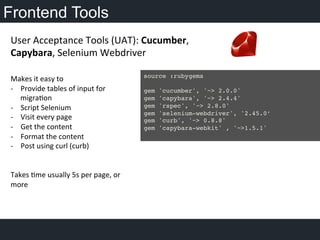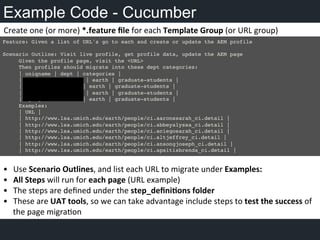How to migrate from any CMS (thru the front-door)
- 1. CIRCUIT – An Adobe Developer Event Presented by ICF Interactive How to migrate any CMS through the front door
- 2. Agenda • About @rockwell105 – Recent Experiences in Content Migration • A process for any CMS • Frontend Tools • Example Code – Cucumber / Step-Definition using Capybara – LSA Department Profile Pages • Demonstration • Summary / Questions – Resources & References
- 3. About Me Chris Rockwell – University of Michigan, LSA • College of Literature, Science and the Arts, Web Services – Technical Lead on AEM project – Neither software consultant nor database expert • API User; Java, Ruby and Frontend – Recent Experience • Database Migration from OpenText • R2Integrated did a great job in migrating our SQL database to AEM – Java classes calling SQL Stored Procedures and creating the content in the JCR – We also used frontend techniques, which I want to talk about today
- 4. Querying the Database Why database migra/ons can be difficult -‐ Requires skills in both systems -‐ Source CMS and target AEM -‐ Source DB table names are like … -‐ vgnAsAtmyContentChannel? -‐ vgnAsAtmyContentObjRef? -‐ Rela/onships between the tables were unclear -‐ In our case, no foreign keys -‐ Legacy system customiza/ons may not be well understood or documented What about the Legacy system API? Or Screen Scraping?
- 5. Migrate ANY CMS HTML CSS JS WordPress AEM OpenText Joomla Drupal MediaWiki Magnolia AssumpOon: Every Web CMS that places content in HTML templates, which provide a consistent HTML Document structure. Template Mapping Old system to New system Group URL’s by template group For each group idenOfy extra informa/on needed to migrate properly
- 6. Data / Screen Scaping hGps://en.wikipedia.org/wiki/Data_scraping “Data scraping is generally considered an ad hoc, inelegant technique, o2en used only as a "last resort" when no other mechanism for data interchange is available. Aside from the higher programming and processing overhead, output displays intended for human consump>on o2en change structure frequently.” For us, some content was much easier (and more fun) to automate a browser and get the content from the frontend. Why it this easier? -‐ Content is consolidated on the page -‐ No reverse engineering of messy legacy systems -‐ Knowledge of the DOM can be used to get content using CSS selectors -‐ Consistent HTML template structure provided by the legacy system -‐ UAT fails if the migraOng URL does not meet assumpOons
- 7. Data / Screen Scaping Other reasons to do this -‐ Going aYer business with no access to the database (POC) -‐ Can be done quickly without knowledge about the legacy system -‐ Can be done in phases (migrates based URL’s listed) -‐ Works against live websites (not stale database snapshots)
- 8. Frontend Tools Makes it easy to -‐ Provide tables of input for migraOon -‐ Script Selenium -‐ Visit every page -‐ Get the content -‐ Format the content -‐ Post using curl (curb) Takes Ome usually 5s per page, or more User Acceptance Tools (UAT): Cucumber, Capybara, Selenium Webdriver source :rubygems! ! gem 'cucumber', '~> 2.0.0'! gem 'capybara', '~> 2.4.4'! gem 'rspec', '~> 2.8.0'! gem 'selenium-webdriver', '2.45.0’! gem 'curb', '~> 0.8.8'! gem 'capybara-webkit' , '~>1.5.1'! !
- 9. Example Code - Cucumber Feature: Given a list of URL's go to each and create or update the AEM profile! ! Scenario Outline: Visit live profile, get profile data, update the AEM page ! !Given the profile page, visit the <URL> ! !Then profiles should migrate into these dept categories:! !| uniqname | dept | categories | !! !| [email protected] | earth | graduate-students | ! !| [email protected] | earth | graduate-students | ! !| [email protected] | earth | graduate-students | ! !| [email protected] | earth | graduate-students |! !Examples:! !| URL | ! !| http://www.lsa.umich.edu/earth/people/ci.aaronssarah_ci.detail |! !| http://www.lsa.umich.edu/earth/people/ci.abbeyalyssa_ci.detail |! !| http://www.lsa.umich.edu/earth/people/ci.aciegosarah_ci.detail |! !| http://www.lsa.umich.edu/earth/people/ci.altjeffrey_ci.detail |! !| http://www.lsa.umich.edu/earth/people/ci.ansongjoseph_ci.detail |! !| http://www.lsa.umich.edu/earth/people/ci.apsitisbrenda_ci.detail | ! • Use Scenario Outlines, and list each URL to migrate under Examples: • All Steps will run for each page (URL example) • The steps are defined under the step_defini/ons folder • These are UAT tools, so we can take advantage include steps to test the success of the page migraOon Create one (or more) *.feature file for each Template Group (or URL group)
- 10. Example Code - Step Definition Given /^the profile page (.*)$/ do | url |! visit url ! end! ! Given /^profiles should migrate into these dept categories:$/ do |table|! @peopleDeptCat = table.raw! @peopleHash = Hash[@peopleDeptCat.map {|key, value, v2| [key, [value, v2]]}]! ! @phone = find("#phone", :visible => false).value! @imageURI = find(".peopleImg")[:src]! @education = find("#education").all('li').collect(&:text) ! ! curlAuthenticate(@profilePath)! buildJsonContent! postContent(@peoplePath, @categoryHash) # create category page! postContent(@categoryPath, @profileHash) # create profile! ….! @c.close! end! ! The Capybara gem provides convenient ways to… • Drive Selenium, visit url • Get content from the page, find(".peopleImg")[:src] A Data Table is passed in from Cucumber lisOng email, department and category. This extra informaOon is used to create the new paths for the migrated pages.
- 11. Example Code- Sling Post Servlet def buildJsonContent! @profileHash = {! "jcr:primaryType"=> "cq:Page",! @uniqueName =>{! "jcr:primaryType"=> "cq:Page", ! "jcr:content"=> {! "jcr:primaryType"=> "cq:PageContent",! ! "officeLocation"=> "#{@officeLocation}",! "jcr:title"=> "#{@firstName} #{@lastName}",! "website1"=> "#{@url}",! "website2"=> "#{@url2}",! "lastName"=> "#{@lastName}",! "cq:template"=> "/apps/sweet-aem-project/templates/department_person_profile",! "officeHours"=> "#{@officeHours}",! "fileName"=> "#{@cvFileName.match(/w*.w{3,4}$/) if [email protected]?}", #! "education"=> @education || "",! "about"=> "#{@about}",! "phone"=> "#{@phone.gsub(/<br>/,', ') if [email protected]?}",! "title"=> "#{@title.gsub(/<br>/,'; ') if [email protected]?}", ! "firstName"=> "#{@firstName}",! "uniqueName"=> "#{@uniqueName}",! "hideInNav"=> "true",! "sling:resourceType"=> "sweet-aem-project/components/pages/department_person_profile",! "cq:designPath"=> "/etc/designs/sweet-aem-project",! "profileImage"=> {! "jcr:primaryType"=> "nt:unstructured",! "sling:resourceType"=> "foundation/components/image",! "imageRotate"=> "0",! },! }! }! } ! Step Defini/on Overview Visit the page, Get the content. Build nested hash(es), which convert nicely to JSON Use *.infinity.json on example content. Use this as a starOng point for the nested hash. def postContent(jcrPath, contentHash)! @c.url = jcrPath! @c.on_success {|easy| puts "ON SUCCESS #{easy.response_code}"}! @c.on_failure {|easy| fail easy.to_s}! @c.http_post("#{jcrPath}", ! Curl::PostField.content(':operation', 'import'),! Curl::PostField.content(':contentType', 'json'),! Curl::PostField.content(':replaceProperties', 'true'),! Curl::PostField.content(':content', contentHash.to_json))! puts "FINISHED: HTTP #{@c.response_code}"! end ! Step Defini/on Overview (cont.) Post JSON to the desired path using :opera/on import The JSON contains a structure needed for the page in AEM containing properOes needed; jcr:primaryType, cq:template, sling:resourceType content hash example
- 12. Legacy System AEM System OperaOon Import SlingPostServlet Wrap-up Demo Questions
- 13. • Several options for Content Migration – Scraping webpages is one option to consider – :operation import is great • Ways to speed up frontend migration – Scale migration across machines using Selenium Grid to launch parallel operations – Use a headless browser Questions Wrap-up Demo
- 14. Resources / References Sling docs haps://sling.apache.org/documentaOon/bundles/manipulaOng-‐content-‐the-‐slingpostservlet-‐ servlets-‐post.html#imporOng-‐content-‐structures U-‐M Demo Project haps://bitbucket.org/cmrockwell/cukescrape Ruby Gems hap://bundler.io/ haps://github.com/jnicklas/capybara haps://github.com/cucumber/cucumber haps://github.com/taf2/curb Selenium Webdriver hap://www.seleniumhq.org/projects/webdriver/ hap://www.seleniumhq.org/docs/07_selenium_grid.jsp Wrap-up Questions Demo










![Example Code - Step Definition
Given /^the profile page (.*)$/ do | url |!
visit url !
end!
!
Given /^profiles should migrate into these dept categories:$/ do |table|!
@peopleDeptCat = table.raw!
@peopleHash = Hash[@peopleDeptCat.map {|key, value, v2| [key, [value, v2]]}]!
!
@phone = find("#phone", :visible => false).value!
@imageURI = find(".peopleImg")[:src]!
@education = find("#education").all('li').collect(&:text) !
!
curlAuthenticate(@profilePath)!
buildJsonContent!
postContent(@peoplePath, @categoryHash) # create category page!
postContent(@categoryPath, @profileHash) # create profile!
….!
@c.close!
end!
!
The
Capybara
gem
provides
convenient
ways
to…
• Drive
Selenium,
visit
url
• Get
content
from
the
page,
find(".peopleImg")[:src]
A
Data
Table
is
passed
in
from
Cucumber
lisOng
email,
department
and
category.
This
extra
informaOon
is
used
to
create
the
new
paths
for
the
migrated
pages.](https://image.slidesharecdn.com/u-mmigration-150811165155-lva1-app6892/85/How-to-migrate-from-any-CMS-thru-the-front-door-10-320.jpg)



